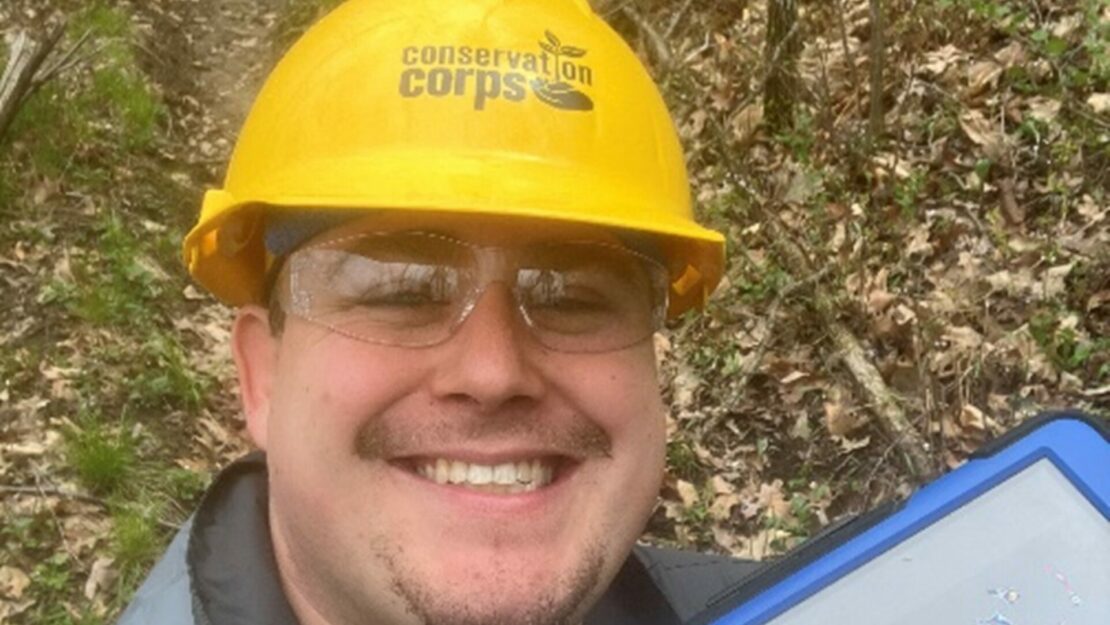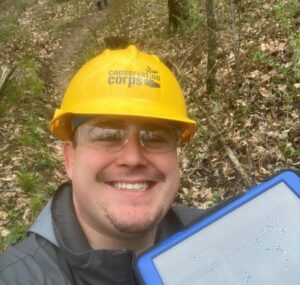Individual Placement Spotlight Series: Brent Cordie

By Jesse Wolk, Utility Mapping Specialist Individual Placement / AmeriCorps Member placed at Minnesota Department of Natural Resources, Division of Parks and Trails
VIII: Talking Trails
The Individual Placement (I.P.) Spotlight Blog is a series of interviews between Jesse Wolk and his fellow I.P. members. The goal of the series is to highlight their unique positions, projects, and backgrounds while simultaneously reflecting on their service term in the context of the Natural Resources career field in Minnesota. In the eighth edition of the series, Talking Trails, the spotlight is shifted to our Off-Highway Vehicle Specialist – Brent Cordie!
All throughout the first backpacking trip I went on, a four day hike in the Grand Canyon, I never thought once about how the trail I was hiking was built. To be honest, I don’t think I’d truly ever considered trail design until I was on a crew performing trail maintenance almost every day for 10 months. Reading materials, learning under the guidance of Outdoor Recreation Specialists, and spending a lot of time bullying the earth with a McLeod, made me realize that most trails are more complicated than simply just existing as a path for my feet to trod on.
Today, unlike interstates or highways, most recreational trails do not attempt to get the user to their destination as quickly as possible. In fact, good trail design almost does the opposite. However, this was not always the case. At the beginning of the 20th century many trails were, “built for utility and speed”. This is largely because most public land managers did not have recreation in mind during their design. The trails they built were for loggers, miners, and transportation of goods. As a result, fast flowing water quickly washed out the straight trails, and their steep grade made them hazardous and relatively inaccessible. Many of these poorly designed trails still exist today, and their environmental impact is well-documented.
In the 1920s and 1930s, the Works Progress Administration developed an ethic for trail building that began to chafe against the western standard. Their method was to build trails as, “…inconspicuous as possible.” Trails began to be built to fit in with their surroundings, had switchbacks making the trail easier to ascend, focused on getting the water off the trail with a consistent downslope grade, and emphasized the construction of scenic vistas. Essentially, the goal shifted from utility and speed to sustainability and beauty. With added cultural and environmental protections that were mandated in the 1960s, trail design has basically had the same ethos for close to a century.
Today, there are many types of recreational trails throughout the United States. The majority are hiking and mountain biking, but a new type of recreation has really risen in popularity over the past few decades: Off Highway Vehicle usage. Off Highway Vehicles (OHVs) are vehicles with large suspension designed for off road driving and include a wide variety of classifications. If you have ever been on one, it can be like driving your own loud, heavy, rollercoaster. They are fun.

With technological advancements, they have become more affordable and easier to use. As a direct outcome, there are now more users. In Minnesota alone, OHV use in the past two decades has doubled. Unfortunately, at the same time, OHVs have gotten heavier. In a classic tragedy of the commons, the increase in users and weight has led to a greater impact on the surrounding environment which has decreased the opportunity for sustainable recreation. With that in mind, people across the country, and in Minnesota, are working to address this challenge. Brent Cordie, the Individual Placement program’s OHV Specialist, is serving with the Minnesota Department of Natural Resources’ Off Highway Vehicle team to do just that.
Brent grew up in Woodbury Minnesota, and like many other of my cohort members that I interviewed, his family instilled an interest in the outdoors through frequent hunting, fishing, and camping trips. When Brent entered undergrad at University of Minnesota – Duluth, he dipped his toes in, “everything under the sun” because he wasn’t sure what he wanted to do. He enjoyed the different perspectives he was gaining and eventually found himself inspired by a professor of Oceanography to pursue Environment, Sustainability, and Geography.

with GPS equipment.
Brent graduated in May of 2022, and he knew he wanted more outdoor experiences. After missing a call to be a crew member for a CCMI Field Crew based out of Duluth, Brent became a CCMI Field Crew lead in the Twin Cities region. During that year of service, Brent most enjoyed the five prescribed burns, and the multiple prairie restoration projects he got to participate in. As his service term was coming to an end, Brent was unsure if he wanted to continue to be a crew lead or if he wanted something different. Ultimately, he ended up applying to positions within the Individual Placement program because he wanted to build his GIS skills, have a hybrid work environment, and was ready for an experience to segue him into the next phase of his career.
In his role as the OHV specialist, Brent has said of himself that he has been a “Jack of all trades but master of none.” Mainly, Brent has said that he has helped with Grant-in-Aid State Forest trail planning. For context, many of the OHV trails are funded through Grant-in-aid programs. For those who do not understand government policy jargon, this means that the DNR funds local organizations to operate and maintain their trails. When they want new trails, or existing trails are changed, they work with the DNR for a design. To facilitate the design process, Brent will walk, or ride, around the trail system to determine the feasibility of the proposed route and the current sustainability status of trail. Additionally, he will use GPS equipment to record the location of the proposed changes of the trail for future design.
Brent has spent the majority of his summer completing projects like the one described at Cloquet Valley, Riverland, Solana, and Richard J. Dorer State Forests. He also told me that sometimes he will just go out for a day with one of his supervisors to just get a visual for how they can better plan their designs. In addition to these fun projects, Brent has spent a lot of time in the office using ArcGIS to verify the accuracy of existing trail systems and DNR databases.

As Brent reflected on his service term, he notes that he feels like he has gained confidence in his abilities. After cutting buckthorn for a year, Brent remarked that it was challenging for him to, “turn his brain back on.” Coming into this position, he was unsure how well he would fit into a position that is fraught with detail and information. Now, he’s happy to say that he can do it! Unlike his experience last service term, Brent also feels like he knows how to communicate with professionals and can now see himself transitioning comfortably into a specialist position within a state, or federal, administrative unit and hopes to eventually work his way to a unit management position.
In a unique way, at the time of my first backpacking trip, my lack of perception on the trail design process reflected my understanding of the natural world. I did realize that essentially everything has felt the pressure of human influence. Minnesota of no exception. All of our natural spaces are designed and managed. We are the greatest threat, and benefactor, to the nature around us. When analyzed for purpose, it can be seen management policy functions to protect our outdoor spaces from ourselves. If trails were not a part of that protection process, then everything would be slowly trampled and the very thing that people were trying to enjoy would be lost. With the post-pandemic recreation boom maintaining itself, we need more positions like Brent’s to manage our trails for the sustainability of our natural systems.
With better design and consistent communication, hopefully, increased usership will translate to awareness and passion on environmental protection issues. If this is the case, then maybe we can avoid the tragedy of the commons and best-case scenario, transform it into a Shakespearian comedy.
Thanks for reading and catch you in a few weeks!
– Jesse Wolk